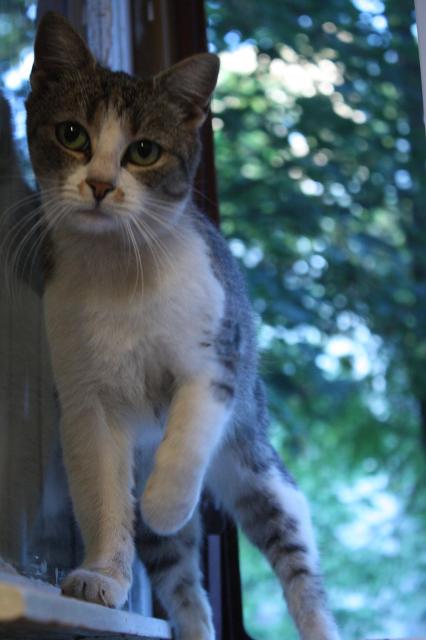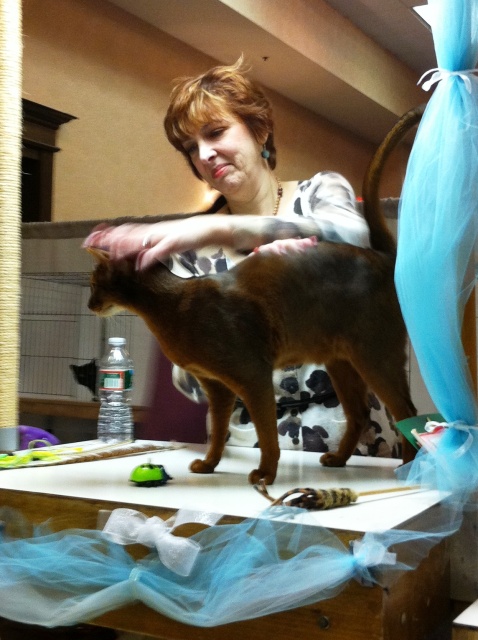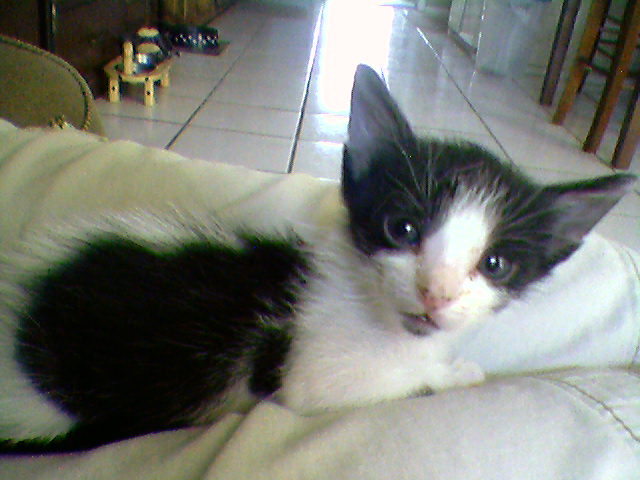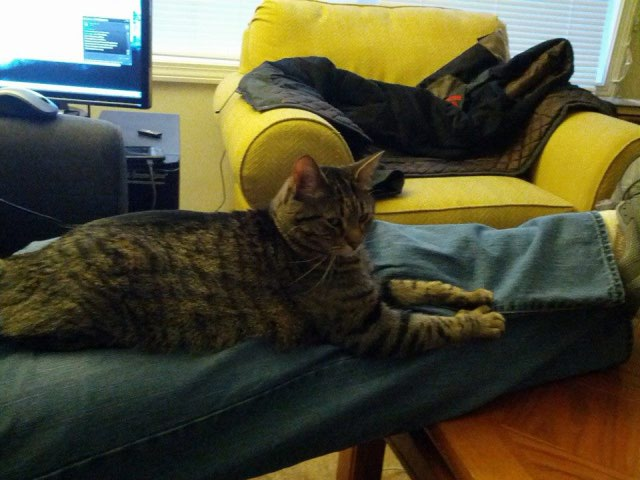QuestionQUESTION: I have been involved with a trap-neuter-return program since last year and would like to know if you have any suggestions on how to trap a pregnant feral. She has been on my property for awhile now and there are two other kitties one of them is her kitty. I don't know how I can separate out the one I need to trap. I sure would like to get her the clinic so she can get proper care. Thank you so much for being there. Juana
ANSWER: Hi Juana,
Glad you have chosen to get involved! Unfortunately, there's no real way to target an exact cat unless you use a box trap. These are generally hand-crafted "traps", which consist of a box propped up on one side with bait underneath. A cord is tied to the prop, and when the desired cat goes underneath the box to eat, you yank the cord. Hopefully, the box will fall quickly enough to trap the cat underneath. There are a couple reasons box traps aren't commonly used for trapping ferals. One - they require you to sit and watch, potentially for hours, until the cat comes to eat so you can pull the prop out. Two, once the cat is under the box, it can be very difficult to transport the cat. If you lift the box up just a little, the cat is going to run for it. You need to find a way to slide something under the box, and keep the cat from wiggling her way out between that surface and the box. If you're handy, you may be able to design something that works. But remember that a feral is generally going to win against a cardboard box. A wooden box with slits to slide in a fitted board below her once she is trapped would be best.
But to stick with your regular humane traps, I would just encourage you to try your best. Whatever you catch should be neutered and released, and in most cases, it will usually take that particular cat a while before they'll go into a trap again. If the pregnant cat isn't the first one you catch, hopefully any others who get trapped in the meantime won't botch your next attempt.
The one thing that might help is to see if you can get mama cat to come for feeding on a different schedule than the other kitties, and then set the trap out when it's time for her meal. This will usually only work with cats who accept some human contact, since you'll need to approach her directly with food, rather than leaving it at a station. And it may take a couple weeks before she's coming for her meals consistently. The other cats might also catch on that there is extra food being given out during this time. But it might be worth a try if nothing else seems to work.
Good luck!
Jessica
---------- FOLLOW-UP ----------
QUESTION: You say one of your specialties is to tame feral cats. I would like to know how I would go about doing this. Thank you Juana
AnswerGood for you! It's a lot of work, but it can be very rewarding if you're willing to try what will seem impossible.
Every feral I've ever come across has become manageable. However, do be aware that each cat will progress differently. Depending on how old they are when you start working with them and their genetic makeup, which determines personality, you may never make a lap cat out of a feral. Many of mine who weren't trapped until they were reproducing adults have become lap cats, and there are people who would argue that this doesn't happen. But if you have the time and dedication, it can.
The thing I must stress most is that you have to be fearless. As I'm sure you are aware, cats are very sensitive to the vibes given off by the creatures around them. Most people approach ferals with fear, perhaps rightfully so. The chances of being swatted at least a few times are about 100%. But making contact with a feral while you are feeling fearful will only reinforce the cat's fear, as well. That will not only encourage the cat to be aggressive, but it will delay your progress. I have accepted that I might get scratched now and then, and taking that with a grain of salt helped melt my fears away. To boost your confidence, you might want to wear a pair of thick gloves while handling your ferals (raptor gloves or dirt-biking gloves work well).
The feral should be kept in a small area, preferably a cage initially. This will allow you to make contact with the cat without a chase, which would only result in extra adrenaline pumping through an already nervous cat. Most cats will shove themselves into a back corner of the cage. I give them about 2 days to settle in, and then I start trying to make physical contact. Most cats will accept some minimal contact on the head right away, although they will protest with growls and hisses. Remain calm, move slowly, speak quietly, and pet the cat anyway. When the cat starts to give you too many warnings that she'll swat, end the contact session.
Over the next day or so, I will begin trying to feed the cat treats by hand. Most cats won't start to accept them from my hand for another week or two, but you can always place the treat down for them to see. The cat will look forward to seeing you once they realize you come with treats like chicken or meat baby food.
Once the cat is accepting petting without much opposition, I will start holding the cat. You should always have a gentle hold of the cat's scruff to try to ensure the cat doesn't run away. I usually start by sitting on the floor with my legs in an open circle. I let the cat curl up in the middle. The cat typically will hide its face, and I just sit there and pet it. I like to do it this way because if the cat DOES freak out, he's not actually on my legs, and my chances of getting scratched are smaller. Normally, they will tolerate the petting for 2 minutes or so before getting very restless, and then I return them to their cage, along with a treat. Do this as often as possible. The more contact you can have with the cat right away, the better. The cat should become less tense with each day.
Most people who get involved with ferals and try to tame them make the mistake of giving the cat too much time to adjust to the home before making physical contact with them. They feel badly that the cat is going through such a stressful time, and they don't want to betray the cat's trust. I can understand those feelings, but I learned the hard way that these cats just tend to become indoor ferals. It's far easier when the cat comes into the home and learns right away that there is going to be human contact. There is only more resistance when you try to introduce this change later.
You ARE taking a risk that you might be scratched or bitten (although I have never been bitten, and my scratches have been minor compared to the ones I've gotten from some house cats). You will have to be comfortable with that risk before you can tame down any ferals. If you don't feel you can accept that risk, sometimes trap-neuter-return is best, unless you are willing to live with a cat who will remain skittish indefinitely. Feral cats who live indoors but are not forced to have human contact will sometimes grow trusting enough to accept petting on their own, but I have never had one that I could say would make an ideal pet.
Good luck!

 Cat meaowing after spayed
QuestionQUESTION: Hello, I am having a problem with my
Cat meaowing after spayed
QuestionQUESTION: Hello, I am having a problem with my
 Best weight-loss plan for Abyssinians?
Question
Overweight Aby?
I have a year and 10 month old
Best weight-loss plan for Abyssinians?
Question
Overweight Aby?
I have a year and 10 month old
 Orphan Kitten Care
Question
My new baby
Hello! Okay, Ill try to sho
Orphan Kitten Care
Question
My new baby
Hello! Okay, Ill try to sho
 identify breed of cat
Question
Male cat 4 years ol
I recently adopted
identify breed of cat
Question
Male cat 4 years ol
I recently adopted
 Chinese Li Hua?
Question
Magnus1
Hi,
My husband and I recently
Chinese Li Hua?
Question
Magnus1
Hi,
My husband and I recently